Tire size can be confusing. Some numbers on the sidewall are listed in millimeters while others are inches. Plus, the right size for your car, truck, or trailer can differ depending on where and how you drive.
You can see your original equipment tire size in your owner’s manual or on the placard generally located on the driver’s side door jam. This is the sizing recommended by the vehicle manufacturer.
If you’re interested in switching out your tires for a different look or performance, a good place to start is the numbers and other indicators on your existing tires’ sidewall. Next, have a tire professional help you determine a tire size range that will fit your vehicle and driving needs.
Here’s what those numbers and indicators on the sidewall indicate and how to understand them:
A: TIRE TYPE The first letter in the code tells you what class of tire it is.
P stands for passenger vehicle tire. P-class tires include cars, SUVs, crossovers, minivans and smaller pickup trucks.
LT means light truck tire, designed for vehicles that are capable of carrying heavy loads, towing trailers, or for those looking for an extra heavy duty option. These are often equipped on three-quarter or 1 ton trucks and SUVs.
ST stands for Special Trailer. These tire sizes are meant for trailers, including fifth wheels and other travel trailers, as well as boat and utility trailers.
If there’s no letter before the first number, you have a metric tire most commonly referred to as European size. It’s also measured in millimeters but may have a different load capacity than a P or LT tire.
B: TIRE WIDTH The three-digit number following the letter is the tire’s width (from side to side, looking at the tire head on) in millimeters. This may also be referred to as the section width.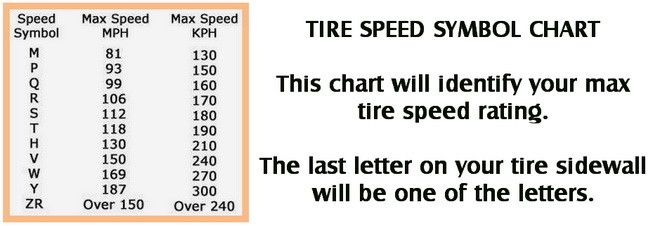
C: ASPECT RATIO The forward slash separates the tire width number from the two-digit aspect ratio. The bigger the aspect ratio, the higher/taller the tire’s sidewall, or “profile” as it’s sometimes called.
The aspect ratio is indicated on the tire sidewall as a percentage. It’s the height of the sidewall measured from wheel rim to top of the tread, expressed as a percentage of tire width.
In this example, the aspect ratio is 65, meaning the sidewall is 65 percent as high as the tire is wide. To get the sidewall height, take the tire width of 215 mm and convert it to inches (8.46). Then multiply this by 65% (.65). This gives you an answer of 5.5, the sidewall height in inches.
D: CONSTRUCTION TYPE This single letter tells you about the internal construction of the tire.
R is for radial tires, the industry standard for most tires today. They have better road grip, lower rolling resistance for better gas mileage, ride comfort and durability than previous generations of tires. In a radial tire, the plies — layers of strong cords made of a blend of polyester, steel and fabric and coated with rubber — are laid perpendicular to the direction of travel.
In a radial tire, the plies — layers of strong cords made of a blend of polyester, steel and fabric and coated with rubber — are laid perpendicular to the direction of travel.
D is for tires built with diagonal (crisscrossed) plies, called bias-constructed tires. They are also called conventional, x-ply, or cross-ply tires. Some motorcycle and trailer tires still use this internal construction.
Some run-flat tires are identified with an F followed by the type of internal construction.
E: WHEEL DIAMETER This two-digit number specifies wheel diameter in inches. It’s the distance between the two bead seat areas (where a tire gets tightly sealed onto the wheel).
F: LOAD INDEX The two-digit or three-digit number that follows the gap specifies tire load index. The load index symbol indicates how much weight a tire can support, based on the following standard chart. In our example, the load index is 89, which indicates the tire has a load capacity of 1,279 pounds, when inflated to the tire’s maximum air pressure rating.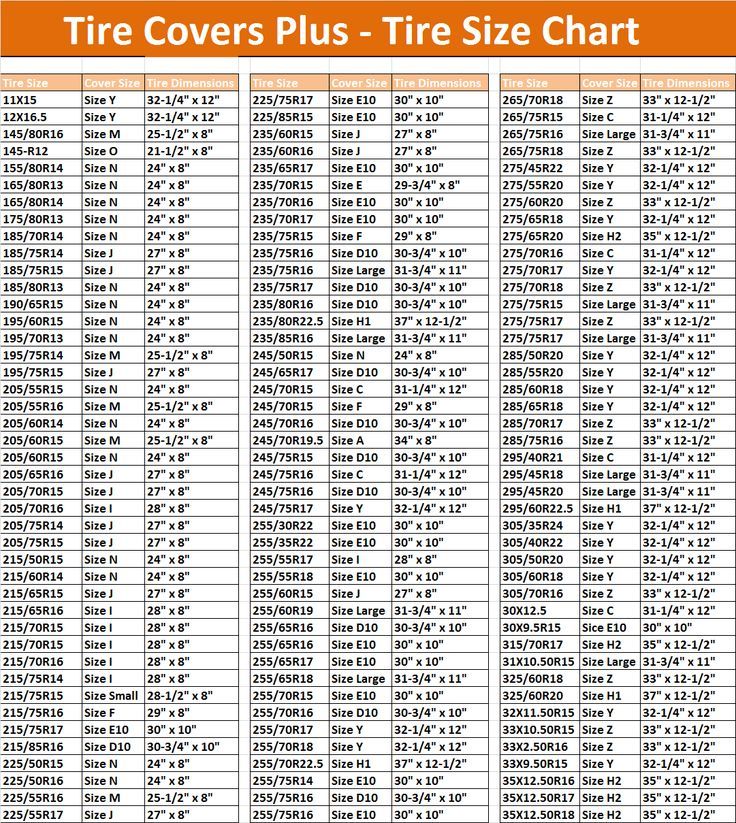
G: SPEED RATING The last letter is the tire speed rating. This indicates the top speed it’s safe to travel at for a sustained amount of time. A tire with a higher speed rating can handle heat better and provide more control at faster speeds. The maximum operating speed of a vehicle is no more than the lowest speed rating of all tires mounted on the vehicle. (Of course, you should always abide by speed limits for safer driving.) Speed rating is usually, but not always, a single letter (see the chart).
Below you will find several charts that will help you understand tire sizing numbers, including a load index chart and speed rating chart.
A tire size calculator is a quick way to see whether the tire size you’re considering will likely fit your car, SUV, sports car, light truck or crossover.
But remember that is only an estimate. It’s important to stay within the sizing tolerances of your vehicle. Tires that are the wrong size could cause some pull in the steering wheel, rub against the suspension or body of your vehicle, reduce clearance on hills, or result in a stiffer or noisier ride.
Tires that are the wrong size could cause some pull in the steering wheel, rub against the suspension or body of your vehicle, reduce clearance on hills, or result in a stiffer or noisier ride.
If you’re considering mounting a different tire size on your vehicle, check with a tire expert. Find out whether the tires and wheels you have your eye on are the right fit for your vehicle’s suspension, gearing, and bodywork. And ask how any differences in revolutions per mile, tire speed, load index, and speed rating will affect your ride quality and vehicle performance.
See how new tires and rims will look on your car or truck using our Virtual Wheels simulator, available at any Les Schwab.
Find Your Store
Want to know how old your tires are or what size your tires are? You need to know how to read tire sidewall information, the alphanumeric code stamped on to the side of your tires. But if you've ever looked at the sidewall of a tire and thought that the blizzard of numbers, letters, and words was as confusing as hieroglyphics, we understand. The alphabet soup on tires' sidewalls can be off-putting, but it's pretty easy once you know what you're looking at.
The alphabet soup on tires' sidewalls can be off-putting, but it's pretty easy once you know what you're looking at.
Beyond the brand (Michelin, Continental, Hankook, etc.) and model names of the tire, the plethora of data stamped on the sidewall is there largely to satisfy government regulations, which require all manner of information—from when and where the tire was built to how durable it is. Not to worry. Let us be your Rosetta stone to deciphering the language of the tire sidewall. The numbers highlighted in pink on the sample tire below correspond to the explanations that follow.
1) These are some of the most important numbers on any tire, as they tell you how big your tires are. In this case, the tire is 245 millimeters at its widest point (when it's mounted on a wheel of a specified width).
2) The number after the slash indicates its aspect ratio, or profile. This tire's sidewall height is 40 percent of its width.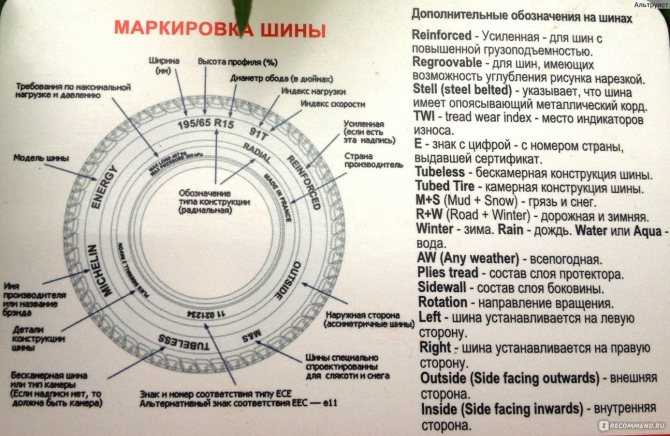
3) The "R" stands for radial construction (rarer bias-ply and belted tires are denoted by a D and B, respectively).
4) The number 18 indicates that this tire fits an 18-inch wheel. Sometimes, letters precede the first number. A "P" stands for p-metric, which is a tire used primarily on passenger cars. An "LT" indicates a light-truck tire. A "T" means it's a temporary spare. Some tires get a "Z" or an "F" attached to the radial indicator, denoting a Z-rated tire (see service description below) or a run-flat tire.
5) This alphanumeric code is the service description, which provides two key insights into the tire's performance: how much weight it can carry and how fast it can run safely—the latter another good indication of whether it's intended for a family sedan or a hot sporty machine. In our example, the "93" stands for the maximum-load rating of 1433 pounds. The letter W denotes the maximum speed rating, which translates 168 mph—not something intended for mom's minivan. See our list of speed ratings below, which range from a low of "L" (just 75 mph for some off-road tires) to a high of Y (186 mph). There is also one special ultrahigh speed rating: If a Y-rated tire has parentheses around its service description, say, "(93Y)," that means the tire is rated for speed "in excess of 186 mph." There are also Z-rated tires, but when that designation came out, no one thought a speed rating in excess of 149 mph would ever be needed. By definition, all W- and Y- rated tires are also Z-rated, though not all get a "Z" embossed on the sidewall.
See our list of speed ratings below, which range from a low of "L" (just 75 mph for some off-road tires) to a high of Y (186 mph). There is also one special ultrahigh speed rating: If a Y-rated tire has parentheses around its service description, say, "(93Y)," that means the tire is rated for speed "in excess of 186 mph." There are also Z-rated tires, but when that designation came out, no one thought a speed rating in excess of 149 mph would ever be needed. By definition, all W- and Y- rated tires are also Z-rated, though not all get a "Z" embossed on the sidewall.
6) Many but not all tiremakers note the heaviest spot of the tire with a red dot. It ultimately has no bearing on tire-and-wheel balance, so it's of little importance.
It ultimately has no bearing on tire-and-wheel balance, so it's of little importance.
A tire's alphanumeric codes reveal everything from how fast it can run to where it was built.
7) The numbers after the word "treadwear" indicate (surprise!) the treadwear of the tire, or how long it's likely to last. The higher the number, the more likely it is that you'll get more miles out of it. But the tests that determine tread life are not exact. The experts at tire-seller Tire Rack report that treadwear ratings can vary. They cite the example of two different tires they sell—one from Goodyear and the other from Continental—both of which offer an 80,000-mile tread-life warranty. You'd expect them to have similar, if not identical, treadwear ratings, but the Goodyear's is 740, while the Continental's is 600. So take this number as an indicator, but not an exact predictor, of how long a tire will last.
8‑9) The letter after the word "traction" is a rating that results from a test of how much grip a tire generates when dragged across wet pavement without the tire rotating. It's not of great relevance to today's cars, which have anti-lock brakes that keep the tires rolling even during emergency braking. The letter following the word "temperature" is an indicator of how well a tire dissipates heat, which increases severely at high speed. Again, it is of less importance than the tire's speed rating, which takes this into account.
It's not of great relevance to today's cars, which have anti-lock brakes that keep the tires rolling even during emergency braking. The letter following the word "temperature" is an indicator of how well a tire dissipates heat, which increases severely at high speed. Again, it is of less importance than the tire's speed rating, which takes this into account.
10‑11) Some tires carry an "M+S" marking, which stands for "mud and snow." It means that the tire has some added capability in those circumstances because it has a little extra space between its tread blocks. But such tires are absolutely not winter (snow) tires and might not even be conventional all-season tires. That's where the three-peak mountain snowflake icon next to the M+S mark comes in. If a tire has that molded into its sidewall, it has significant snow capability and should be considered a viable winter tire.
12) This area of the tire may display what's called the original-equipment (OE) marking.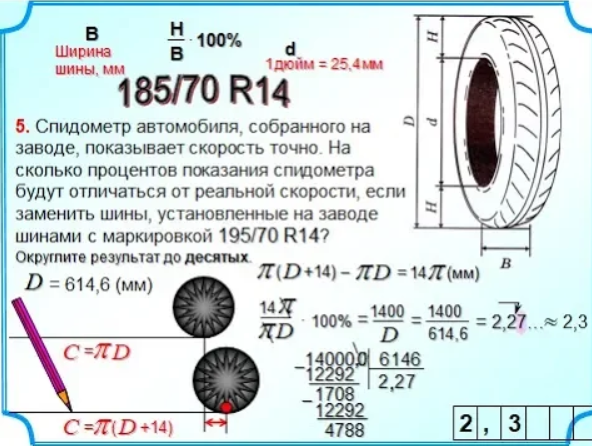 Automakers sometimes take a standard, off-the-rack commodity tire and modify its construction or rubber compound to work better on one of their models. So, a Ford Escort and a Chevy Cruze might both be equipped with Firestone Firehawk AS tires that look virtually identical, but each car's tires might differ significantly in ways that affect the ride and handling. If your vehicle's tires carry an OE code, it's best to replace them with the same brand and model of tire wearing the same code—if you can. Tire stores and online retailers can help you with finding tires with the correct OE code for your vehicle.
Automakers sometimes take a standard, off-the-rack commodity tire and modify its construction or rubber compound to work better on one of their models. So, a Ford Escort and a Chevy Cruze might both be equipped with Firestone Firehawk AS tires that look virtually identical, but each car's tires might differ significantly in ways that affect the ride and handling. If your vehicle's tires carry an OE code, it's best to replace them with the same brand and model of tire wearing the same code—if you can. Tire stores and online retailers can help you with finding tires with the correct OE code for your vehicle.
13) This is a list of the tire's construction materials, of interest primarily to tire engineers and tire geeks.
14) Every tire sold in the U.S. must have U.S. Department of Transportation (DOT) labeling. The first two characters indicate the factory of manufacture, and the next five or six are manufacturer-specific jargon (for tracking purposes, as in the case of a recall). The last four numbers give the date of production which let you know how old your tires are with the first two digits indicating the week and the latter two the year (for example, "2318" means that tire was produced in the 23rd week of 2018). The European equivalent of the DOT code may also be present (it starts with an "e"), although fewer manufacturers are printing both on a tire's sidewall. If this string of numbers ends with "-S," it means the tire complies with European noise regulations.
The last four numbers give the date of production which let you know how old your tires are with the first two digits indicating the week and the latter two the year (for example, "2318" means that tire was produced in the 23rd week of 2018). The European equivalent of the DOT code may also be present (it starts with an "e"), although fewer manufacturers are printing both on a tire's sidewall. If this string of numbers ends with "-S," it means the tire complies with European noise regulations.
Tire Rack
Buy Now
Tire Rack
Buy Now
Tire Rack
Buy Now
Tire Rack
Buy Now
Dave VanderWerp
Director, Vehicle Testing
Dave VanderWerp has spent more than 20 years in the automotive industry, in varied roles from engineering to product consulting, and now leading Car and Driver's vehicle-testing efforts. Dave got his very lucky start at C/D by happening to submit an unsolicited resume at just the right time to land a part-time road warrior job when he was a student at the University of Michigan, where he immediately became enthralled with the world of automotive journalism.
Dave got his very lucky start at C/D by happening to submit an unsolicited resume at just the right time to land a part-time road warrior job when he was a student at the University of Michigan, where he immediately became enthralled with the world of automotive journalism.
Do you want to choose a tire for your car, but do not understand tire markings well? It's not a problem! In this section, we will help you figure out what tire parameters are, what they mean, and which tire is right for your car.
Find tires / tire catalog
195/65 R15 91 TXL
195 is the tire width in mm.
65 - Proportionality, i.e. profile height to width ratio. In our case, it is equal to 65%. Simply put, with the same width, the larger this indicator, the higher the tire will be and vice versa. Usually this value is simply called “profile”.
Usually this value is simply called “profile”.
Since the tire profile is a relative value, it is important to take into account when choosing rubber that if you want to put tires with a size of 205/65 R15 instead of the size 195/65 R15, then not only the width of the tire will increase, but also the height! Which in most cases is unacceptable! (except when both of these sizes are indicated in the car's operating book). You can calculate the exact data on changing the outer dimensions of the wheel in a special tire calculator.
If this ratio is not specified (for example, 185/R14C), then it is equal to 80-82% and the tire is called full profile. Reinforced tires with this marking are usually used on minibuses and light trucks, where a large maximum wheel load is very important.
R - means a tire with a radial cord (in fact, almost all tires are made this way now).
Many mistakenly believe that R- means the radius of the tire, but this is precisely the radial design of the tire. There is also a diagonal design (indicated by the letter D), but recently it has practically not been produced, since its performance is noticeably worse.
There is also a diagonal design (indicated by the letter D), but recently it has practically not been produced, since its performance is noticeably worse.
15 - wheel (rim) diameter in inches. (It is the diameter, not the radius! This is also a common mistake). This is the “landing” diameter of the tire on the disk, i.e. is the inside size of the tire or the outside of the rim.
91 - load index. This is the level of maximum permissible load on one wheel. For passenger cars, it is usually done with a margin and is not a decisive factor when choosing tires (in our case, IN - 91 - 670 kg.). For minibuses and small trucks, this parameter is very important and must be observed.
T - tire speed index. The larger it is, the faster you can ride on this tire (in our case, IS - H - up to 210 km / h). Speaking about the tire speed index, I would like to note that with this parameter, the tire manufacturer guarantees the normal operation of the rubber when the car is constantly moving at the specified speed for several hours.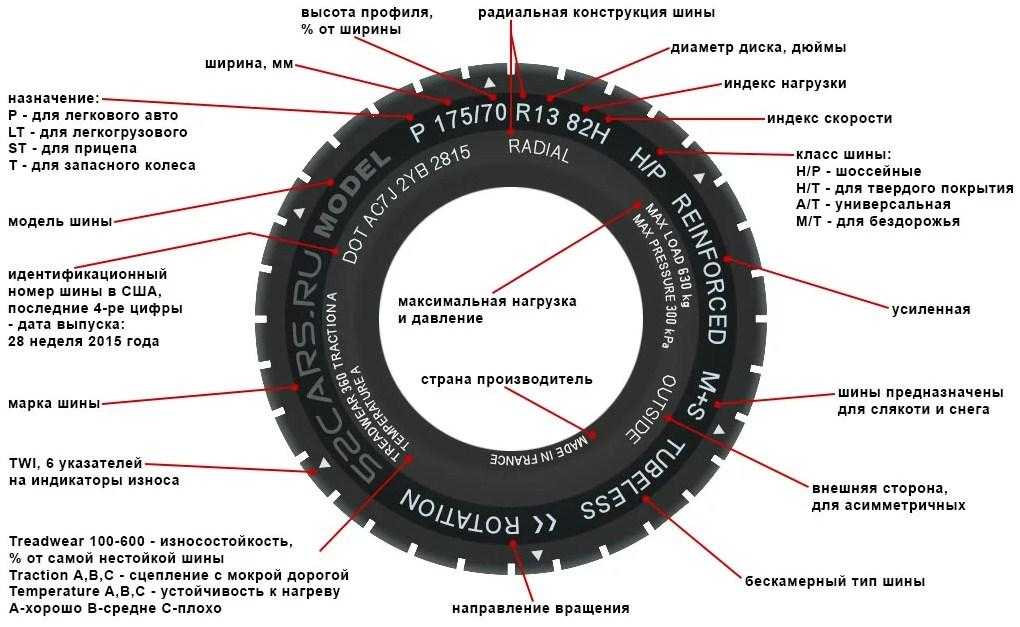
There are two different markings for American tires. The first one is very similar to the European one, only the letters “P” (Passanger - for a passenger car) or “LT” (Light Truck - light truck) are placed before the size. For example: P 195/60 R 14 or LT 235/75 R15. And another tire marking, which is fundamentally different from the European one.
Example: 31x10.5 R15 (corresponding to European size 265/75 R15)
31 is the outside diameter of the tire in inches.
10.5 is tire width in inches.
R - a tire with a radial design (older tire models were with a diagonal design).
15 is the inner diameter of the tire in inches.
Generally speaking, except for inches that are unusual for us, the American tire marking is logical and more understandable, unlike the European one, where the height of the tire profile is not constant and depends on the width of the tire.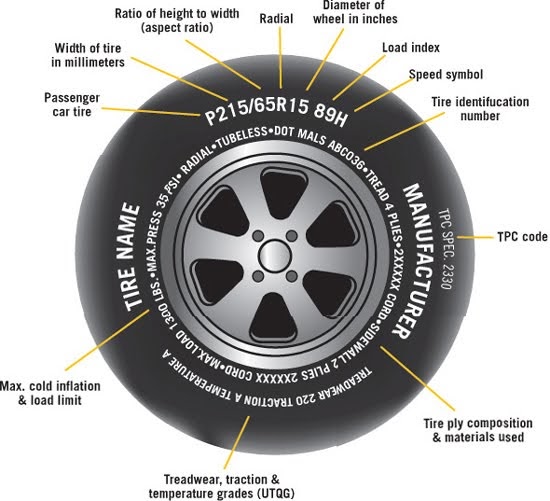 And here everything is simple with decoding: the first digit of the standard size is the outer diameter, the second is the width, the third is the inner diameter.
And here everything is simple with decoding: the first digit of the standard size is the outer diameter, the second is the width, the third is the inner diameter.
XL or Extra Load is a reinforced tire, the load index of which is 3 units higher than that of conventional tires of the same size. In other words, if a given tire has a load index of 91 marked XL or Extra Load, then this means that with this index, the tire is able to withstand a maximum load of 670 kg instead of 615 kg (see the table of tire load indices).
M+S or M&S tire marking (Mud + Snow) - mud plus snow and means that the tires are all-season or winter. Many summer tires for SUVs are labeled M&S. However, these tires must not be used in winter, as winter tires have a completely different rubber compound and tread pattern, and the M&S badge indicates good flotation performance.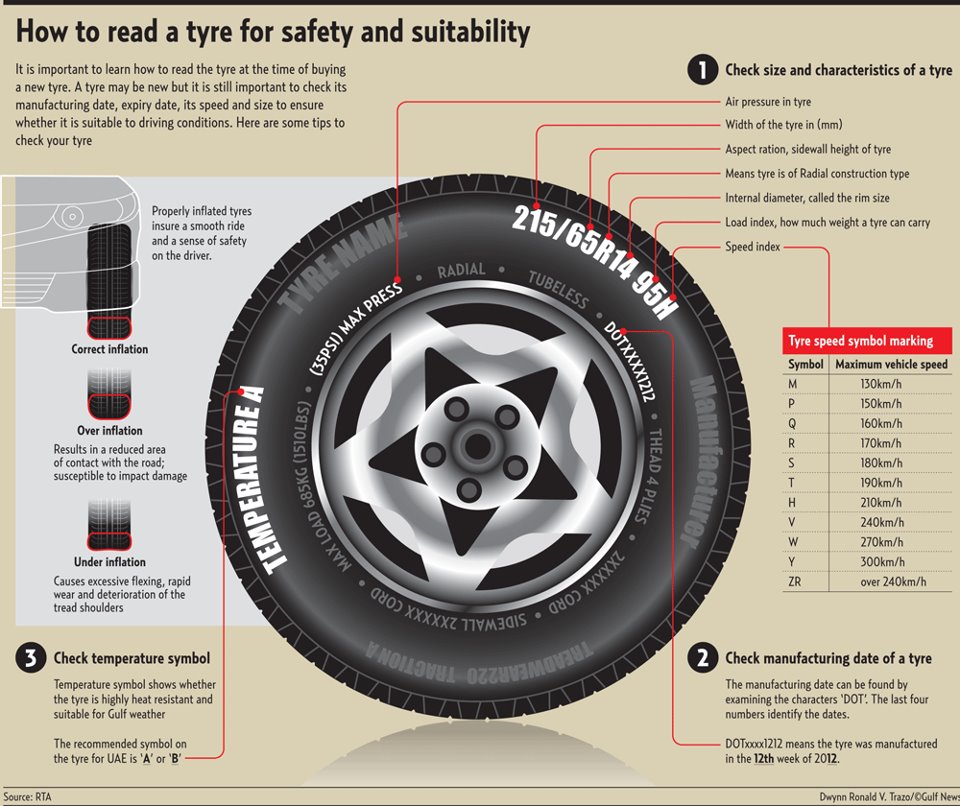
All Season or AS all season tires. Aw (Any Weather) - Any weather.
Pictogram * (snowflake) — rubber is designed for use in harsh winter conditions. If this marking is not on the sidewall of the tire, then this tire is intended for use only in summer conditions.
Aquatred, Aquacontact, Rain, Water, Aqua or pictogram (umbrella) - special rain tires.
Outside and Inside ; asymmetric tires, i.e. It is important not to confuse which side is the outside and which is the inside. When installing, the Outside inscription must be on the outside of the car, and Inside on the inside.
RSC (RunFlat System Component) - RunFlat tires are tires on which you can continue to drive a car at a speed of no more than 80 km / h with a FULL drop in pressure in the tire (due to a puncture or cut). On these tires, depending on the manufacturer's recommendations, you can drive from 50 to 150 km. Different tire manufacturers use different designations for RSC technology. For example: Bridgestone RFT, Continental SSR, Goodyear RunOnFlat, Nokian Run Flat, Michelin ZP etc.
Different tire manufacturers use different designations for RSC technology. For example: Bridgestone RFT, Continental SSR, Goodyear RunOnFlat, Nokian Run Flat, Michelin ZP etc.
Rotation or arrow This marking on the tire sidewall indicates a directional tire. When installing the tire, you must strictly observe the direction of rotation of the wheel, indicated by the arrow.
Tubeless - tubeless tire. In the absence of this inscription, the tire can only be used with a camera. Tube Type - indicates that this tire must be used only with a tube.
Max Pressure ; maximum allowable tire pressure. Max Load - the maximum allowable load on each wheel of the car, in kg.
Reinforced or the letters RF in the size (for example 195/70 R15RF) means that this is a reinforced tire (6 layers). The letter C at the end of the size (for example 195/70 R15C) indicates a truck tire (8 layers).
Radial this marking on the rubber in the standard size means that this is a radial construction tire.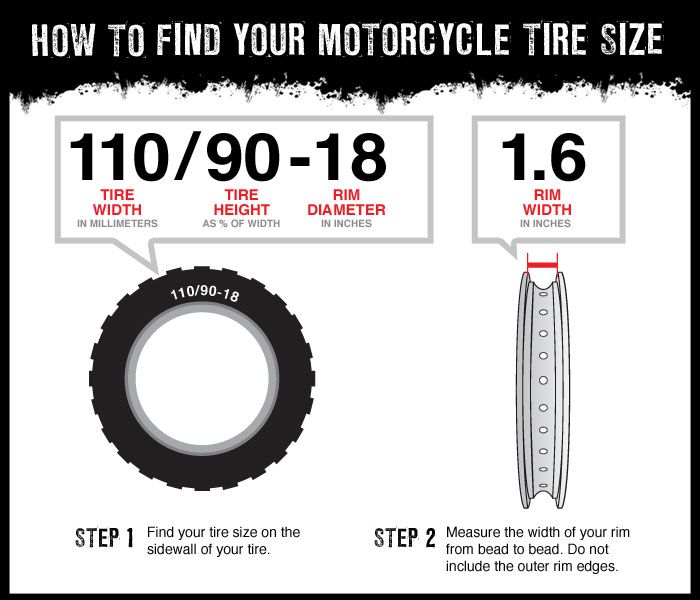 Steel means that there is a metal cord in the tire structure.
Steel means that there is a metal cord in the tire structure.
Letter E (in a circle) - the tire meets the European requirements of ECE (Economic Commission for Europe). DOT (Department of Transportation - US Department of Transportation) is an American quality standard.
Temperature A, B, or C Temperature resistance of the tire at high speeds on the test bench (A is best).
Traction A, B, or C Tire wet braking capability.
Treadwear ; relative expected mileage compared to a specific US standard test.
TWI (Tread Wear Indiration) - tire tread wear indicators. The marking on the TWI wheel can also be with an arrow. Pointers are located evenly in eight or six places around the entire circumference of the tire and show the minimum allowable tread depth. The wear indicator is made in the form of a protrusion with a height of 1.6 mm (the minimum tread value for light vehicles) and is located in the tread recess (usually in the drainage grooves).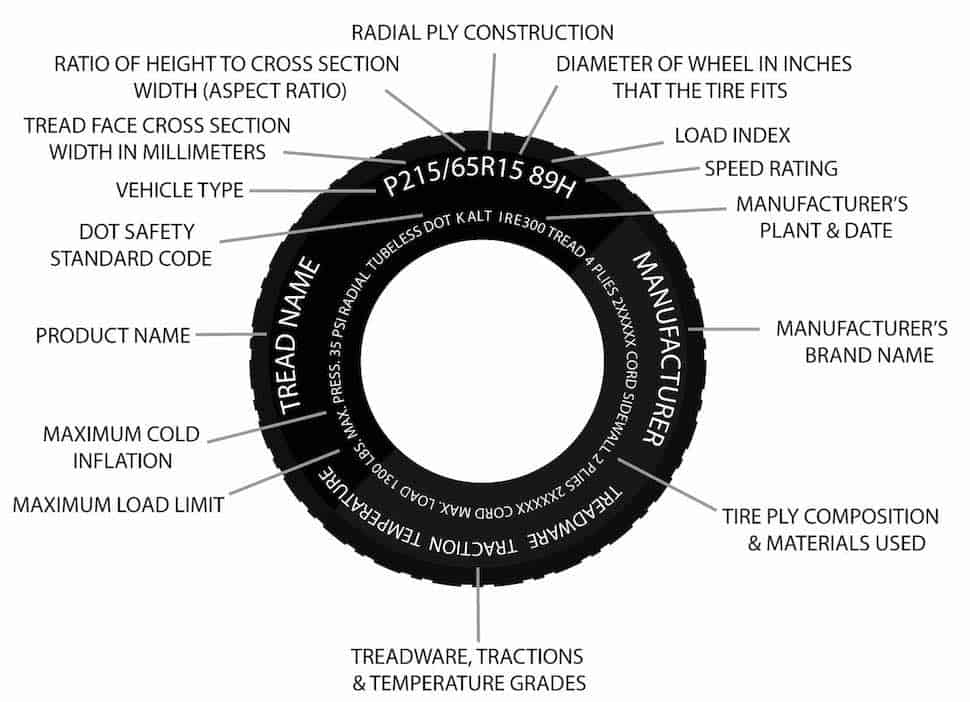
DOT - Manufacturer's coded address, tire size code, certificate, issue date (week/year).
Find tires / tire catalogPhoto: Shutterstock
adv.rbc.ru
See also
Numbers and letters on a car tire provide all the necessary information about it. True, it is not easy to read them - here, even in the designation of one parameter, several measurement systems can be used simultaneously. In addition, many values are expressed in special indices. We decipher all important labels for the buyer.
adv.rbc.ru
A tire label is information about its properties printed on the outer rim. This is a huge amount of useful information. Here are the parameters of the tire that can be read from it itself:

The size designation is written in the form XXX/XX R XX. For example 225/65 R17.
The first three digits are the tire width in millimetres. In our case - 225 mm.
The second digit is the height, but not in millimeters, but as a percentage of the width. In our case, its height is 146.25 mm (225 * 0.65).
The third number after R is the outside diameter of the wheel or the inside diameter of the tire in inches. In our case, this is 17 inches or 43.18 cm. Do not confuse - this is the radius, not the diameter. The letter R itself stands for the radial design of the tire, which confuses many. Sometimes Radial can be written separately on the bus - the meaning is the same. In addition to the radial, there is also a diagonal design (D), but these are not found today.
Two numbers and a letter immediately follow the size. These are the codes for the load capacity and speed limit of the tire.
These are the codes for the load capacity and speed limit of the tire.
Two digits - capacity or load index. This is a complex system of values, in which the larger the number, the greater the load, but the step size between the values is not constant. Therefore, it is easier to just know the most common of them:

The index value is the load on each wheel separately. To calculate the total load capacity, multiply by 4. This value can also be written elsewhere in a simpler form: Max load - xxx kg.
Photo: Shutterstock
The letter after the two digits of the load index is the index of the maximum speed for which the tire is designed. It starts with A, but the values relevant for modern machines start with the second half of the Latin alphabet:
This is not the limit, but the maximum "comfortable" value. In exceptional cases, you can even exceed it by 20-30%, but it is better to avoid this.
Another key parameter is the time the tire was produced. Usually it is indicated in a rounded rectangle, but may be without a frame. The first two digits are the week, and the second two are the year.
Also, three more parameters are usually indicated on the tire - wear resistance margin, grip quality class and temperature index.
The wear index is denoted by the word treadwear. Its unit is 480 km. Multiply the number next to that word by that value. If treadwear is 400, it means that under test conditions at the test site, such a tire has worn out after driving 192,000 km. Also, this parameter can be designated separately as the abbreviation TWI.
Traction is a measure of how well a tire grips on wet road surfaces. It has values from AA - the best level, to CC - the worst. Tires for regular passenger cars usually have class A, and the highest class is for sports and racing.
Temperature is the tire's ability to withstand heat when driving at a certain speed.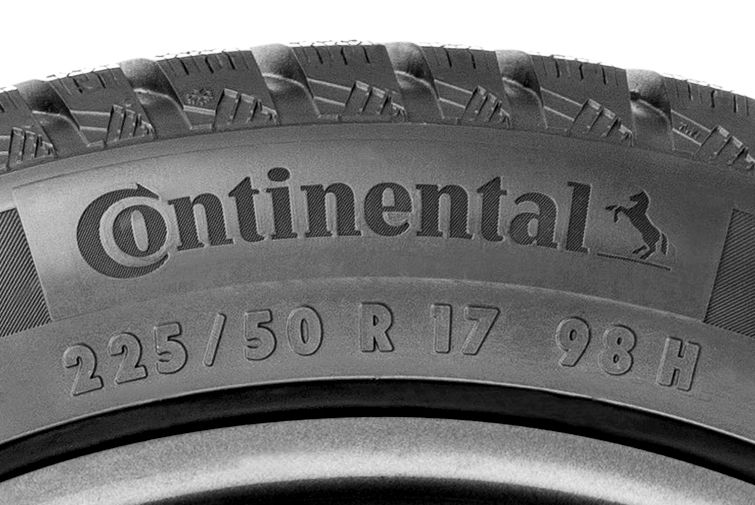 There are three values here:
There are three values here:
Tires of modern passenger cars most often have this index value - A.
Photo: Shutterstock
The letter E with a number indicates that the tire complies with the rules of the European Tire Standards Association (ETRTO) and has a corresponding certificate . The number indicates the country that issued it - but this does not matter, since the ETRTO requirements are the same. In this case, the tire can be produced anywhere.
The weather conditions in which this tire is allowed to be used are also usually indicated:
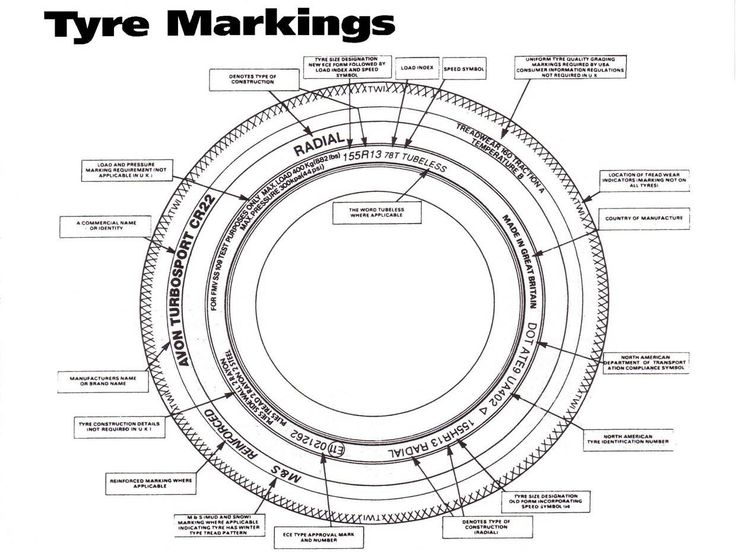
Winter tires must have a first, second or third designation.
On some tires you can find the designation of the type of car for which they are intended:
In addition, the tire may be marked:
